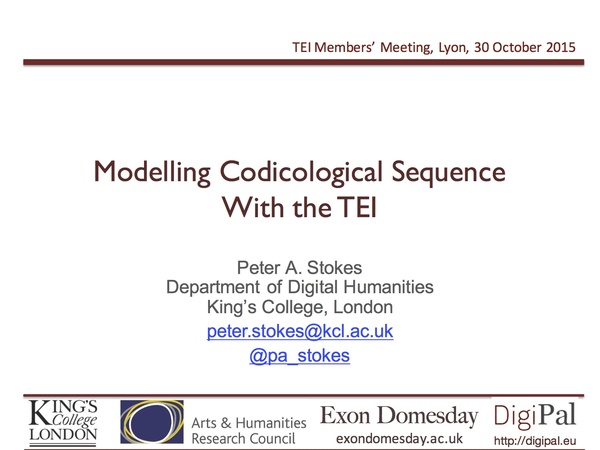Modelling Codicology II: A Partial Draft Implementation
In the first post in this series, I presented the challenge of modelling the codicological structure of a manuscript: not just the page, or the text, but rather how the different pages fit together as bifolia, singletons and so on. I have since developed this further, through a partial implementation using TEI and Schematron. This was presented at the recent TEI conference in Lyon, and I plan to write it up formally, but in the meantime I hope it may be helpful to post here: this is partly in response to recent discussion on the TEI MS-SIG mailing list, but is also both for your interest and to solicit comments and feedback from you. I have only posted the slides without text, so it may be helpful to explain that part of my objective was to see just how far one could get using TEI. The answer seemed to be 'a pretty long way', insofar as a combination of TEI and Schematron allows one to check many of the rules that I presented in the first post. Furthermore, representing the codicological structure as an 'OHCO' means that the tree structure of the resulting XML very closely matches the structure of the manuscript, and this means that the built-in visualisation of XML editors such as Oxygen provides a fairly natural way of manipulating the text in terms of its physical pages. That is, one can take the XML, read or edit it in Oxygen's Author view, then switch to the tree structure ('Outline' view in Oxygen) and drag and drop the pages and quires. The Schematron rules will alert you if your arrangement violates any of the rules, and you can then look again at your text in Author view to see how it is changed in the new arrangement. Such a process is therefore possible, but I would not generally recommend it. This is partly because encoding the text, the page and physical structure all in one was not particularly easy or natural because it involves conflating very different models. Furthermore, simply dragging and dropping sections of text is all very well for a single editor but is difficult to manage on a larger scale and does not allow others to test alternative strategies. Hence a proper interface is required, and a means of recording different hypotheses regarding the arrangement. Exactly how such an interface would work is a major task of the Exon Domesday project.
That's a brief summary of the talk, anyway. The slides are attached as a PDF below, and the latest version of a (partial) implementation in TEI and accompanying Schematron are available as Gists on GitHub. Please note that the implementations are very much experimental drafts as a proof of concept and are not intended for serious use (which is partly why they are Gists and not on GitHub proper). However, I hope they are useful as an alternative way of expressing what I have in mind, and of demonstrating some possible directions in which this could potentially be developed.
Enjoy, anyway, and please do let me know what you think.
Slides of paper for TEI 2015. Click to download file as PDF.
Share on Twitter Share on Facebook
Comments